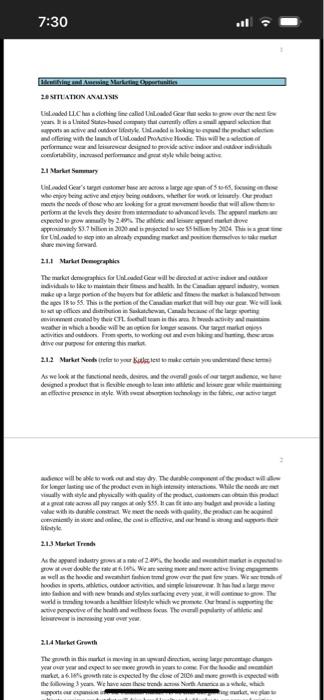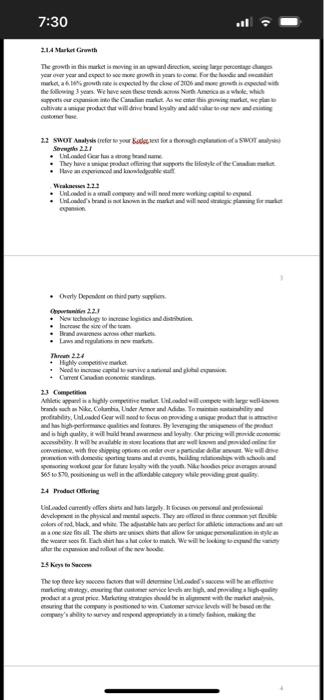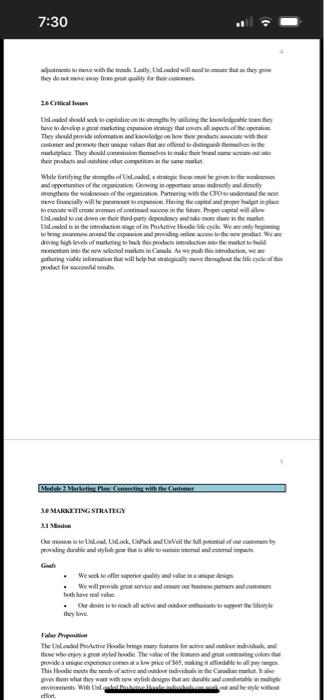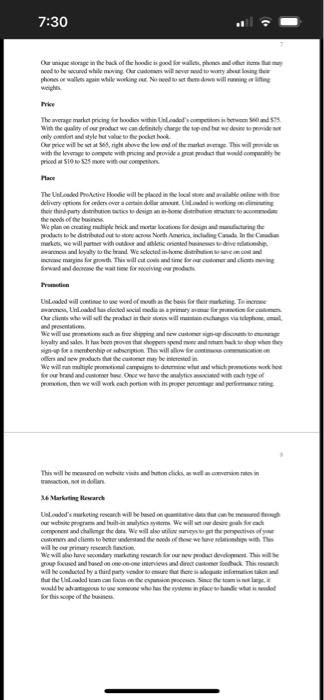Question
***PLEASE HELP WITH SECTIONS 4.0 through 5.3.*** GB530M3-3: Develop strategic marketing plans. Brand Extension Marketing Plan In this assessment, you will complete and submit an
***PLEASE HELP WITH SECTIONS 4.0 through 5.3.***
GB530M3-3: Develop strategic marketing plans.
Brand Extension Marketing Plan
In this assessment, you will complete and submit an entire Brand Extension Marketing Plan (BEMP) on the behalf of an existing for-profit organization. Using the Marketing Plan guide found in Course Documents, you will put together a comprehensive BEMP. Be sure to review the Sample Marketing Plan (Pegasus Sports International) in Chapter 2 of your Kotler text.
You need to first assume you have the role of a marketing manager for one new (currently not available) product on the behalf of a real, for-profit organization. Consider this a brand extension. You are adding a product to an existing companys product line. This product may be introduced on a local, regional, national, or international scale.
It is very important that you fully comprehend what a brand extension is before you begin your major assessment. Find brand extension in your Kotler text and make certain you understand the definition. Brand extensions fall into two categories: line extension and category extension. Be sure to understand the difference. Reading this section in your text will be extremely helpful to you!
Give careful thought to your selection. Note:You must submit your selected brand extension to your instructor for prior approval. Remember that the proposal is for a new product for a new market. Extend the brand name into a new product offering. In other words, offer a new to the company product. Companies may do this by buying an existing product, by importing a new product and putting their own name on it, or by developing their own new product to compete in the market.
Be sure to follow the Brand Extension Marketing Plan directions contained in the guide located in the Course Documents area. It is important to address each and every question/segment in order to receive maximum points. Remember that a fully-executed marketing plan contains a significant amount of detail! You can also find a good Sample Marketing Plan (Pegasus Sports International) in Chapter 2 of your Kotler text.
Be sure to thoroughly address each of the following questions in your Marketing Plan submission along with reviewing the rubric.
Key Questions to Answer:
- What is the brand name of your for-profit business/organization?
- What is the new product, not currently in existence, that will generate revenue for which you will prepare a marketing plan and strategy during this class? Give the product a name and briefly describe it.
- Look up brand extension in your Kotler text and describe whether your product is considered a line or a category extension.
- How will you acquire information to prepare your marketing plan during this class? What research will you undertake? Be specific.
- Will your new product be marketed domestically or globally? Why?
- Describe the key customer market (i.e., who are you targeting?).
Once complete with identifying your new product for a new market along with addressing the outlined questions, continue by completing an entire Brand Extension Marketing Plan (BEMP).
1.0 Executive Summary
In 4 - 6 paragraphs, summarize your Brand Extension Marketing Plan. Be sure to include:
- Product
- Benefits
- Target markets
- Customer needs
- Value proposition
- How you would market on a national and global level
- Show an understanding of other cultures, global relationships, and global dynamics in the marketplace
2.0 Situational Analysis
Write a 1-paragraph summary of the current situation. Write this section after completing the following sections of the Situation Analysis, but put it in this order.
[Keep the outline numbering and main headings in your plan, but delete all advice and content prompts and questions from the plan. Address all those elements, but omit the questions and direction prompts.]
2.1 Market Summary
(Write this section after completing 2.1.1, 2.1.2, 2.1.3, 2.1.4, and 2.2)
In a 1 - 2 paragraph summary, address:
- What are your target customer groups? Why?
- What are your projections for the growth of this market?
2.1.1 Market Demographics (refer to your Kotler text for helpful definitions/explanations)
- Carefully define the demographic profile of your target market.
- In a similar fashion, define the geographic target area you are choosing.
- What are the behavior factors that will influence your decision-making?
- Define the values and lifestyles (psychographics) of your target market.
2.1.2 Market Needs (refer to your Kotler text to make certain you understand these terms)
- What are the benefits that are important to your customer base? What needs do they have?
- Include both customer needs and the customer value assessment.
2.1.3 Market Trends
- Identify and explain at least three trends that will influence how your customers view your product. These should be trends going on in the industry or the environment; these are trends that your company/product can respond to in some way. Remember: Trends are long term; fads are short term.
2.1.4 Market Growth
- Is the market growing, static, or diminishing? What are the growth trends?
- What is the evidence? What research are you using to determine market growth?
- How will you address the market if it is growing, static, or diminishing?
2.2 SWOT Analysis (refer to Chapter 2 of your Kotler text for a thorough explanation of a SWOT analysis)
2.2.1 Strengths list and describe at least three positive internal aspects that add value.
2.2.2 Weaknesses list and describe at least three negative internal aspects that place you at competitive disadvantage.
2.2.3 Opportunities list and describe at least three opportunities external to your business that will lead to your success.
2.2.4 Threats list and describe at least three threats external to your business that will threaten your success (e.g., it is common to include unexpected acts of nature, government and regulatory concerns, and competition in this section of the SWOT).
2.3 Competition
- Describe your competition.
- Why will customers prefer your product?
- How will you compete with your competition and win?
- What is the marketing mix (price, place, promotion, product, you know them as the 4 Ps of Marketing) of at least one of your competitors?
2.4 Product Offering (refer to your Kotler text to make certain you understand these terms)
- What are the current products you offer?
- How will your new product fit in with existing products? Is there a good fit between them?
2.5 Keys to Success
- List and describe at least three factors that will determine your success.
2.6 Critical Issues
- How will you leverage your SWOT strengths and opportunities to your advantage?
- How will you lessen the impact of your SWOT weaknesses and threats?
- Where is your product in the product life cycle and why? Refer to your Kotler text for a definition of a product life cycle.
3.0 Marketing Strategy
3.1 Mission (review mission in Chapter 2 of the Kotler & Keller Marketing Management text)
- Establish the fundamental goals for the quality of your business/product offering and customer satisfaction.
- Define your business/product offering.
- What are your fundamental goals? (Fundamental goals are those that you would like to achieve with your new product, either as an individual product or as part of the overall company mission. These are directional goals that provide the overall strategic direction for management planning.)
- State the value proposition. Be sure to look up this term in your Kotler text if you dont fully understand it.
3.2 Marketing Objectives
Include a sentence or two about each of the following:
- What are your specific marketing objectives?
- Market share: what is your growth objective by quarter?
- Market penetration: how do you plan to gain a share in this market?
- Awareness: how do you plan to gain awareness for your product?
- Customer acquisition: how do you plan to grow your customer base?
- Identify a specific, measurable market share and size.
Remember that your objectives need to be quantifiable. In other words, objectives need to have a base point, end point, and time frame so you can research to see if you have reached your benchmarks or if your plan needs adjustment.
3.3 Target Markets (refer to Chapter 9 of your Kotler text to make sure you fully understand what is meant by target market segments)
- Identify the specific target market segments you have defined. What are the market niches you hope to capture? Describe.
- Include the rationale behind why these are the optimal target marketing segments. Be specific.
3.4 Positioning (refer to your Kotler text for definition of terms in this section)
- Describe how your product/service meets the need(s) of your target market segments.
- Describe how you are different from your key competition.
- What is the most distinguishing feature of your new product?
3.5 Marketing Mix
Product
- What makes your product different from the competition?
- What gives your product more value than the competition?
Price
- What price will you charge and how will you determine what price to charge for your product?
- How will you determine what your product is worth?
- How will your pricing strategy set you apart from your competition?
Place
- How do you plan to distribute your product?
- Do you have alternative delivery methods in mind? If so, describe in detail.
- Will you take responsibility for distribution, or will you rely on an outside firm? How will you decide?
Promotion
- What kind of promotional tools will you use? Describe in detail.
- How will you determine what promotional tactics will work best?
- With a limited promotional budget, how do you plan to gain market share?
- How will you go about evaluating the results of your promotional campaign?
3.6 Marketing Research (refer back to Chapter 4 of your Kotler and Keller text for help with this section).
- What type(s) of marketing research do you think will work best to get you the information you need to make informed decisions?
- How will you evaluate whether the research is providing you with the results you need?
- Will you conduct the research yourself, or hire an outside firm? Explain why.
Note: Do not forget that you need research to determine if you reached your Objectives in 3.2.
4.0 FINANCIALS
TIP: Refer to your sample marketing plan at the end of Chapter 2.
4.1 Break-Even Analysis
- Explain when you will break-even.
- Include a break-even table/chart.
- Explain the break-even table/chart.
4.2 Sales Forecast
- Include your sales forecast for the first year by month.
- For the second and third years, include your forecasts by quarter.
- Identify the risks you face.
- Identify the most important components of sales performance.
- Keep your chart(s) relatively simple and reduce the total number of categories so that your investors can quickly discern the information.
4.3 Expense Forecast
List your expenses for the following items for the next 3 years:
- Website
- Advertising
- Printed Material
- Development of retail channel
- Other (list)
5.0 Controls
- How will you monitor expenses/revenue?
- Identify what methods/reports and how often.
- How will you assess marketing effectiveness?
- How will you assess changes in the market environment?
5.2 Marketing Organization
- Roles and Relationships in Your Marketing Functions (who will be responsible and who will implement this Brand Extension Marketing Plan?).
5.3 Contingency Planning
- Identify risks
- How you will monitor risks
- How you will adapt to adversity
Tips
- Be sure to review the Competency Assessment Rubric in order to understand the criteria on which you will be evaluated.
- The guide you should use for your Brand Extension Marketing Plan is in Course Documents.
- The Kotler and Keller text will be extremely useful to you when completing components of your Brand Extension Marketing Plan. Be sure to review the Sample Marketing Plan (Pegasus Sports International) in Chapter 2 of your Kotler text.





Step by Step Solution
There are 3 Steps involved in it
Step: 1

Get Instant Access to Expert-Tailored Solutions
See step-by-step solutions with expert insights and AI powered tools for academic success
Step: 2

Step: 3

Ace Your Homework with AI
Get the answers you need in no time with our AI-driven, step-by-step assistance
Get Started


